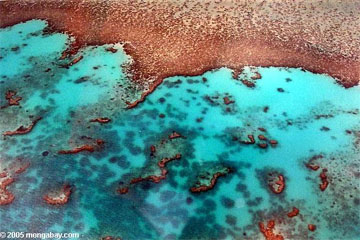Climate change threatens coldwater reefs
Ecological Society of America
April 3, 2006
Corals don’t only occur in warm, sun-drenched, tropical seas; some species are found at depths of three miles or more in cold, dark waters throughout the world’s oceans. Some cold-water coral reefs are home to more than 1,300 species of animals, a diversity rivaling some better known tropical coral reefs. Until now, scientists believed bottom trawling — a commercial fishing method in which vessels drag large, heavily weighted nets across the bottom — to be the greatest threat to cold-water corals. Now, however, a new study published in Frontiers in Ecology and the Environment suggests that human activities could be threatening cold water reefs in another way.
Lead researcher John Guinotte, a marine biogeographer at Marine Conservation Biology Institute (Bellevue, WA) and colleagues say that increasing amounts of atmospheric carbon dioxide (CO 2 ), driven by the burning of fossil fuels, are dissolving into the oceans, causing them to become slightly more acidic. This change in seawater chemistry could harm deep-sea calcifying animals like corals.
Cold-water corals that make their skeletons from aragonite — a form of calcium carbonate (the main component of limestone) — are most vulnerable. Cold-water, reef-building corals are prevalent in the North Atlantic, where there is a deep layer of water supersaturated with aragonite. In pre-industrial times, more than 95 percent of cold water reefs around the world were found in waters supersaturated with aragonite. However, this layer of supersaturated water is shrinking as concentrations of CO 2 increase.
“Scientists have known for years that shallow-water tropical coral reefs are threatened by both warming oceans and chemical changes in seawater caused by the build-up of CO 2 in the atmosphere. Above-average seawater temperatures have caused coral bleaching events throughout the world, and the calcification rates of corals exposed to more acidic conditions in laboratory experiments have shown worrisome declines,” says Guinotte. “But now we suspect that this increase in CO 2 will have a detrimental effect on cold-water corals as well. Cold-water reefs are at greater risk than shallow-water reefs because colder waters are naturally less hospitable for coral growth.”
 The Great Barrier Reef in Australia. Like tropical coral reefs, cold-water reef ecosystems are threatened by rising concentrations of carbon dioxide, which acidifies seawater. RELATED ARTICLES Pacific Ocean getting warmer and more acidic March 31, 2006 The Pacific Ocean is getting warmer and more acidic, while the amount of oxygen is decreasing, due to increased absorption of atmospheric carbon dioxide say scientists from the National Oceanic and Atmospheric Administration’s Pacific Marine Environmental Laboratory and the University of Washington. Pacific Ocean getting warmer and more acidic November 17, 2005 Australia’s Great Barrier Reef could lose 95 percent of its living coral by 2050 should ocean temperatures increase by the 1.5 degrees Celsius projected by climate scientists. The startling and controversial prediction, made last year in a report commissioned by the World Worldwide Fund for Nature (WWF) and the Queensland government, is just one of the dire scenarios forecast for reefs in the near future. |
The uptake of CO 2 by oceans initiates a series of chemical reactions that increase acidity and decrease carbonate ion concentration in seawater. Corals and other marine organisms (e.g. some species of plankton and mollusks) use carbonate ions to build their skeletons or shells. Model projections indicate that by 2100, only 30 percent of cold-water reefs will still be in waters supersaturated with aragonite. With fewer carbonate ions available, there could be a dramatic reduction in the growth of both the corals and marine plankton species that make their shells from aragonite. As the oceans become more acidic, corals are expected to build weaker skeletons, a process similar to osteoporosis in humans.
Cold-water corals provide habitat for many commercially important fish species and harbor several species of sponges that produce chemicals with anti-cancer and other medicinal uses. Unfortunately, says Guinotte, just as scientists are finding out how diverse and important cold-water corals are, they are being threatened by a one-two punch.
“First, bottom trawlers smash them to bits. Then, ocean acidification will probably slow the skeletal growth and/or lead to weaker skeletons of those that remain. Ocean acidification will likely have serious and wide-reaching impacts, not only for coral ecosystems but for all life in the oceans. Many species of marine plankton use carbonate ions and occupy the base of most marine food webs, so a reduction in their numbers could lead to harmful effects throughout marine ecosystems.”
Only a decrease in the burning of fossil fuels is likely to slow this trend, say Guinotte and colleagues.
Will human-induced changes in seawater chemistry alter the distribution of deep-sea scleractinian corals? Front Ecol Environ 2006; 4(3): 141—146
Authors:
John Guinotte, Marine Conservation Biology Institute, TESAG-James Cook University
James Orr, Laboratoire des Sciences du Climat et del ‘ Environnement
Stephen Cairns, National Museum of Natural History, Smithsonian Institution
Andre Freiwald, Institute of Paleontology, University of Erlangen
Lance Morgan, Marine Conservation Biology Institute
Robert George, George Institute for Biodiversity and Sustainability
This is a modified news release from the Ecological Society of America.